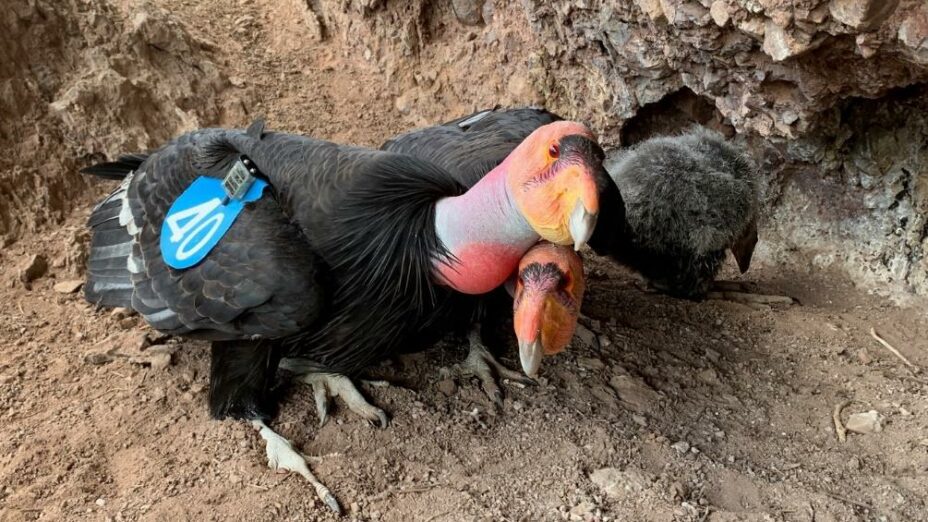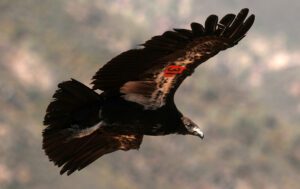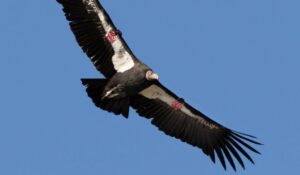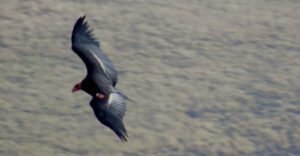
Soaring over mountains, deserts, and forests, the California condor’s 10-foot wingspan means it can fly hundreds of miles in a day—even the length of the entire Diablo Range.
Before it was driven nearly extinct by lead poisoning, egg poaching, and other hazards, the California condor had a historical range that stretched not just throughout California, but to Florida, northern Mexico, and western Canada, according to the US Fish & Wildlife Service.
We’ve been working to support research on the California condor’s recovery as its population and range re-expands. Now, we’re happy to announce that we’ve just approved a $9,396 grant to the Pinnacles Condor Recovery Program to fully fund nine more long-range GPS trackers for young condors.
These young condors will soon be establishing their own territories, potentially nesting in new locations in the northern Diablo Range.
From Pinnacles to Mount Diablo

Young California condor in flight. Photo courtesy of Erin Lehnert, National Park Service
In 2021, Condor 828 crossed the skies from Pinnacles National Park, visiting Mount Diablo. It was the first California condor to visit Contra Costa County for over a century.
This news was a big deal; the story was a historic conservation victory. The California condor was back.
“Many of us have waited our whole lives for this kind of great news,” said Seth Adams, Save Mount Diablo’s Land Conservation Director.
But we didn’t have to wait another lifetime for more great news. In mid-2022, another condor visited the Mount Diablo region; it was seen soaring over Brushy Peak Regional Preserve near Livermore before returning to Pinnacles National Park.
Beginning in 2023, could we have more exciting news? With a growing condor population re-expanding its range, will condors begin to nest closer to Mount Diablo sometime soon?
Tracking Long Flights

Pinnacles Condor 828 soaring through the skies. Photo by Tim Huntington
Given the California condors’ ability to fly such long distances, specific GPS trackers are needed to fully track their movements and understand their current range.
Last year, Save Mount Diablo previously helped to fund nine long-range GPS trackers that have been used to track young condors, the most likely individuals to travel to new locations as the population grows.
The findings were extraordinary. The flight paths of the young condors were tracked throughout the Diablo Range, illustrating the steady expansion of the species range as the young condors explore new territory.
Both condors that were recorded within the Diablo region were a part of the Pinnacles Condor Recovery Program, which is currently working to expand our ecological understanding in an effort to locate new nest locations.

Condor movements throughout the northern Diablo Range. Courtesy of the National Park Service
Could Condors Nest near Mount Diablo?
All of the GPS trackers will be placed on young condors, who have yet to establish their own territory and find a mate.
In 2023, they’ll fly far and wide in search of their own territories. The rock formations and outcroppings on Mount Diablo could be ideal habitat for them to nest.
If the condor recovery continues successfully, we can hope that a condor pair will choose to nest and raise their young on Mount Diablo. It will be historic, the first nesting pair of condors in this region in over a century.
What we think is even more likely: these overlapping GPS tracks will show that the condors are increasingly flying the length of the Diablo Range, demonstrating how important it is, and that it’s a significant wildlife corridor with still intact connectivity and rich biotic features.
And given their protected status, the condors will increasingly play a role in stopping bad developments and infrastructure projects on their habitat while encouraging more land conservation.
Thanks to these GPS trackers, we’ll follow along as the condors’ range expands. Our hope is that one day we’ll be as likely to see condors flying overhead as we are golden eagles.

California condor flying at the Bitter Wildlife Refuge in Kern County. Photo by Beatrix Schwartz
Top: Condor pair at Pinnacles National Park. Photo courtesy of Gavin Emmons, National Park Service

